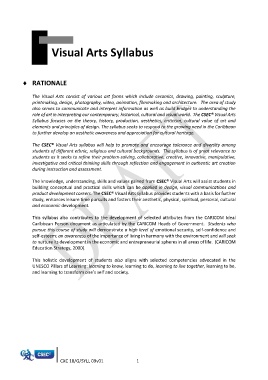Page 1402 - SUBSEC October 2017_Neat
P. 1402
Visual Arts Syllabus
RATIONALE
The Visual Arts consist of various art forms which include ceramics, drawing, painting, sculpture,
printmaking, design, photography, video, animation, filmmaking and architecture. The area of study
also serves to communicate and interpret information as well as build bridges to understanding the
role of art in interpreting our contemporary, historical, cultural and visual world. The CSEC® Visual Arts
Syllabus focuses on the theory, history, production, aesthetics, criticism, cultural value of art and
elements and principles of design. The syllabus seeks to respond to the growing need in the Caribbean
to further develop an aesthetic awareness and appreciation for cultural heritage.
The CSEC® Visual Arts syllabus will help to promote and encourage tolerance and diversity among
students of different ethnic, religious and cultural backgrounds. The syllabus is of great relevance to
students as it seeks to refine their problem-solving, collaborative, creative, innovative, manipulative,
investigative and critical thinking skills through reflection and engagement in authentic art creation
during instruction and assessment.
The knowledge, understanding, skills and values gained from CSEC® Visual Arts will assist students in
building conceptual and practical skills which can be applied in design, visual communications and
product development careers. The CSEC® Visual Arts syllabus provides students with a basis for further
study, enhances leisure time pursuits and fosters their aesthetic, physical, spiritual, personal, cultural
and economic development.
This syllabus also contributes to the development of selected attributes from the CARICOM Ideal
Caribbean Person document as articulated by the CARICOM Heads of Government. Students who
pursue this course of study will demonstrate a high level of emotional security, self-confidence and
self-esteem; an awareness of the importance of living in harmony with the environment and will seek
to nurture its development in the economic and entrepreneurial spheres in all areas of life. (CARICOM
Education Strategy, 2000).
This holistic development of students also aligns with selected competencies advocated in the
UNESCO Pillars of Learning: learning to know, learning to do, learning to live together, learning to be,
and learning to transform one’s self and society.
CXC 18/G/SYLL 09v01 1

